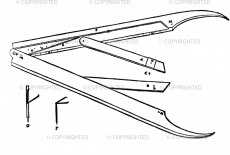Military Compasses
From Inventions
m (1 revision) |
|||
| Line 1: | Line 1: | ||
{{Template invention | {{Template invention | ||
| - | |nome= | + | |nome= |
| + | Name used here (the inventor assigned it no specific name) to indicate the instrument's chief application. | ||
|inventore= Carlo Teti | |inventore= Carlo Teti | ||
| Line 7: | Line 8: | ||
|data= 1575 | |data= 1575 | ||
| - | |descrizione= | + | |descrizione= |
| + | Described by Carlo Teti (1575) as an instrument of military use, this compass was a forerunner of the better-known [[Geometric and Military Compasses | geometric and military compass]] of Galileo. The legs are 11/4 palms long, so that when opened they form a ruler one braccio long, serving as unit of measurement; engraved on their sides are various scales and units of measurement such as the palm and the Roman foot. Two arms pivoting on the legs serve to lock the compass setting at right angles to form a [[Gunner's Suqare | gunner's suqare]] or a [[quadrant]]. Engraved on the sides of these arms are the degree scale and the shadow square. The curved points serve to measure calibers and, through the relevant weight scale, to calculate the weight of cannonballs. Other operations described by the author include dividing angles and circumferences into equal parts, reading diurnal and nocturnal hours, surveying the layouts of buildings and territories (using special sights mounted on the compass legs), determining direction in excavating mines and tunnels, levelling planes and "other things, which I will omit insofar as they are not truly necessary ...". | ||
|componenti= | |componenti= | ||
Revision as of 11:50, 13 November 2009
Name used here (the inventor assigned it no specific name) to indicate the instrument's chief application.
Contents |
Inventor
Carlo Teti
Historic Period
1575
Description
Described by Carlo Teti (1575) as an instrument of military use, this compass was a forerunner of the better-known geometric and military compass of Galileo. The legs are 11/4 palms long, so that when opened they form a ruler one braccio long, serving as unit of measurement; engraved on their sides are various scales and units of measurement such as the palm and the Roman foot. Two arms pivoting on the legs serve to lock the compass setting at right angles to form a gunner's suqare or a quadrant. Engraved on the sides of these arms are the degree scale and the shadow square. The curved points serve to measure calibers and, through the relevant weight scale, to calculate the weight of cannonballs. Other operations described by the author include dividing angles and circumferences into equal parts, reading diurnal and nocturnal hours, surveying the layouts of buildings and territories (using special sights mounted on the compass legs), determining direction in excavating mines and tunnels, levelling planes and "other things, which I will omit insofar as they are not truly necessary ...".
Bibliographical Resources
Teti, Carlo. Discorsi delle fortificationi, del sig. Carlo Tetti, ove diffusamente si dimostra, quali debbano essere i siti delle fortezze... et altre cose a loro appartenenti, con le figure di esse, Venetia, appresso Bolognino Zaltiero, 1575.
Images
Author of the entry: Filippo Camerota

